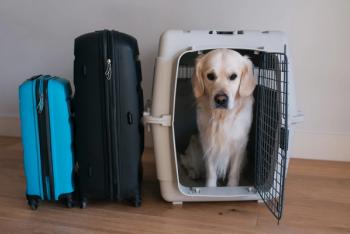
Border crossing
Washington - Federal agencies charged with monitoring animal imports are spread too thin and don't have enough of a clear, overall vision to effectively keep animal diseases from entering the United States, according to a new report from the Government Accountability Office.
Washington — Federal agencies charged with monitoring animal imports are spread too thin and don't have enough of a clear, overall vision to effectively keep animal diseases from entering the United States, according to a new report from the Government Accountability Office (GAO).
The problem, first reported by DVM Newsmagazine back in March, is that with four agencies—the U.S. Department of Agriculture (USDA), the Fish and Wildlife Services (FWS), the Centers for Disease Control and Prevention (CDC) and Customs and Border Protection (CBP)—all in charge of different pieces of the animal import puzzle, there are significant "gaps that could allow the introduction and spread of zoonotic diseases and diseases affecting wildlife," GAO says in its November 2010 report, titled "Live Animal Imports: Agencies Need Better Collaboration to Reduce the Risk of Animal-Related Diseases."
"No single entity has comprehensive responsibility for the zoonotic and animal disease risks posed by live animal imports," states GAO, noting that the United States legally imported more than 1 billion live animals from 2005 to 2008.
Puppy imports are posing an increasing threat to the health of companion animals, thanks to Americans' growing appetite for purebred puppies and a crackdown on domestic puppy mill operations, according to sources from DVM Newsmagazine's March report titled "Breed Wars." And the current system of monitoring puppy imports leaves many dangerous loopholes, officials say.
"One thing that really concerns veterinarians is, underage puppies come in and not only are they at greater risk of zoonotic diseases, but also other canine diseases," Nina Marano, DVM, of the Center for Disease Control and Prevention's (CDC) Division of Global Migration and Quarantine, told DVM Newsmagazine in March. "It is a concern. It's a consumer issue; it's a public health issue; it's a veterinary issue. Really, it's a moral and ethical issue."
CDC has a rough idea of how many puppies are crossing United States borders, but only anecdotally, Marano explained.
"The fact is that we have a very big country and many, many ports of entry to monitor," she continued. "We've been looking at this closely over the last five to six years and ... the takeaway message is that, anecdotally, we do believe there has been an increase in imported animals."
But an increase in animal imports does not equal an increase in resources to monitor those imports for disease, notes the new GAO report. The United States is the world's leading import market for live animals, but the GAO says zoonotic diseases have represented about 75 percent of new emerging infectious diseases over the last few years.
What's lacking is an overall plan of attack and system of accountability for monitoring animal imports, suggests GAO. Five statutes govern animal importation—the Animal Health Protection Act (USDA Animal and Plant Health Inspection Service), the Lacey Act (FWS), the Endangered Species Act of 1973 (FWS), the Public Health Service Act (CDC), and the Tariff Act of 1930 (CBP)—and they weren't designed to work in tandem.
"As we have previously reported, when responsibilities cut across more than one federal agency—as they do for the regulation of live animal imports to prevent the introduction and spread of diseases—it is important for agencies to work collaboratively," says GAO. "The federal government must identify ways to deliver results more efficiently in a way that is consistent with its multiple demands and limited resources."
CBP is responsible for overseeing all imports and enforcing the regulations set forth by APHIS, CDC and FWS. USDA APHIS veterinarians inspect live animal imports at 15 ports along the Mexican border, 20 ports along the Canadian border, 30 airport locations across the United States and maintain several animal quarantine facilities. CDC staff are not present at all ports of entry but rely on APHIS, CBP and FWS to enforce its regulations. CDC also maintains 20 quarantine stations across the United States. FWS has about 120 wildlife inspectors to handle all shipments at 49 ports of entry nationwide, as well as seven ports on the Mexican border, 24 ports on the Canadian border and 18 other air, ocean and rail ports.
Not only does the GAO report highlight the fact that these agencies are spread thin in regard to the volume of imports they have to monitor, but points out that a lack of communication between the agencies only makes the problem worse.
GAO points to several past criticisms of the current system, one from 2005 by the National Academies (NAS) that refers to a "patchwork of federal policies and agencies with limited or ill-defined jurisdiction" and a "significant gap in preventing and rapidly detecting emergent diseases (with) a lack of coordinated federal oversight."
"It is found that wildlife are imported daily with little or no health monitoring, increasing likelihood that zoonotic or animal diseases will enter the United States," NAS reported at the time.
Follow-up studies confirmed NAS' 2005 sentiments, with a 2009 study in CDC's own Emerging Infectious Diseases journal concluding that mammal imports "provide numerous opportunities for zoonotic pathogens to enter the United States." The study recommended increased surveillance, but the GAO says "CDC does not fully use its statutory authority to prevent the importation of live animals that may pose a risk of zoonotic diseases."
Previous reports by the USDA's Office of the Inspector General also confirm knowledge of problems with disease surveillance.
"An August 2010 audit report identified weaknesses in the procedures APHIS used to handle animals destined for a quarantine facility, beginning with the precautions it took when receiving animals into the country and continuing to the conditions at the quarantine facilities," says GAO. "APHIS officials did not identify these weaknesses because they did not exercise sufficient oversight to ensure import and quarantine requirements were met. ... A 2008 audit on APHIS's control over live animal imports indicated that APHIS relies on health certificates from the exporting country to certify the animal's health, condition, age and other import requirements."
A new system—the Veterinary Services Process Streamlining System—was initiated by APHIS in June 2010 to address these problems, but has not been a complete solution, GAO says. Most of the experts surveyed by GAO told the agency that while APHIS does not regulate the importation of all live animals, it should take on a broader role. APHIS unveiled a new long-term plan in 2008 called VS2015, which is consistent with the One Health concept, that would expand its role, but the plan does little for the short-term.
In the meantime, dangerous imports continue—ones that could reach the neighborhood veterinarian's office. One example of this is surveillance of companion animals entering the country without dependable proof of vaccinations against diseases like rabies.
"While CDC requires proof of current rabies vaccination and the confinement of most dogs for up to 30 days after vaccination, it has received reports of large-volume shipments of puppies intended for immediate resale. According to agency officials, these animals often appear younger than the age on their accompanying documents, that is, they are too young to receive an effective rabies vaccination, and their vaccination status is questionable.
"If CDC finds at ports of entry that a dog was not vaccinated for rabies, the agency allows it to enter, if the owner agrees to keep the dog confined until it can be properly vaccinated and then confined for an additional 30 days following the vaccination to prevent the potential spread of rabies," GAO reports. "However, state and local agencies that are to monitor confinement frequently lack resources to do so, according to CDC officials."
Marano told DVM Newsmagazine in March that CDC can only manage "snapshots" of data to gauge dog import trends and found that of the 287,000 dogs imported in 2006, about a quarter of them were too young to have rabies vaccinations. Their importers were required to sign agreements stating the dogs would be confined until the vaccine was administered. More than 5,100 confine agreements were signed between January 2006 and September 2007 at 15 of the 20 quarantine stations monitored by the CDC, but about 4,000 of those agreements were violated in 2006 alone, with the puppies being sold before the confinement period ended. There's no telling if any had been vaccinated at all.
And dogs aren't the only species that could show up at a suburban veterinary office. Mice, rats and gerbils are not screened for zoonotic diseases, even though the animal family to which they belong has been found to harbor 21 different zoonotic diseases, adds GAO, and CDC does not require rabies vaccinations for cats—which are "highly susceptible to certain strains of rabies virus and can also transmit the infection to humans," the report says.
"CDC generally reacts only when a zoonotic disease problem arises," GAO says. "(Its) regulation of live animal imports does not sufficiently protect against zoonotic disease risks, according to the experts responding to our survey and scientific studies."
CDC expects to make some changes in 2011, the report notes, taking into consideration the results of a survey on animal imports it conducted in 2007.
GAO also reports that all the agencies play a part in animal disease surveillance.
"On average, it takes about four years for FWS to identify a species or group of species as injurious to wildlife. During this time, the animals in question continue to be imported into the United States," GAO reports, adding that FWS typically performs visual inspections that are often ineffective because it is often difficult to distinguish between a healthy animal and an apparently healthy but infected animal. Even healthy animals can carry pathogens, the reports says.
Still, the main problem, as one expert interviewed for GAO noted, is the failure of the system to maintain an big-picture view of the entire importation process. The agencies focus on those components under their statutory authority.
APHIS, Customs, CDC and several southern California animal agencies have taken the first step toward better collaboration by creating a new task force to reduce illegal puppy importations on the Mexican border.
"These strategies are positive steps toward furthering the common goal of preventing disease risk from live animal imports," GAO says. "Collaborating agencies need to establish strategies that work in concert with those of their partners."
GAO recommends that the secretaries of Agriculture, Health and Human Services, Homeland Security and the Interior develop a unified strategy. All the agencies generally agreed with the report's findings, GAO says.
Newsletter
From exam room tips to practice management insights, get trusted veterinary news delivered straight to your inbox—subscribe to dvm360.






